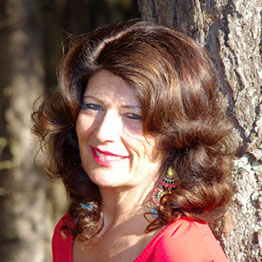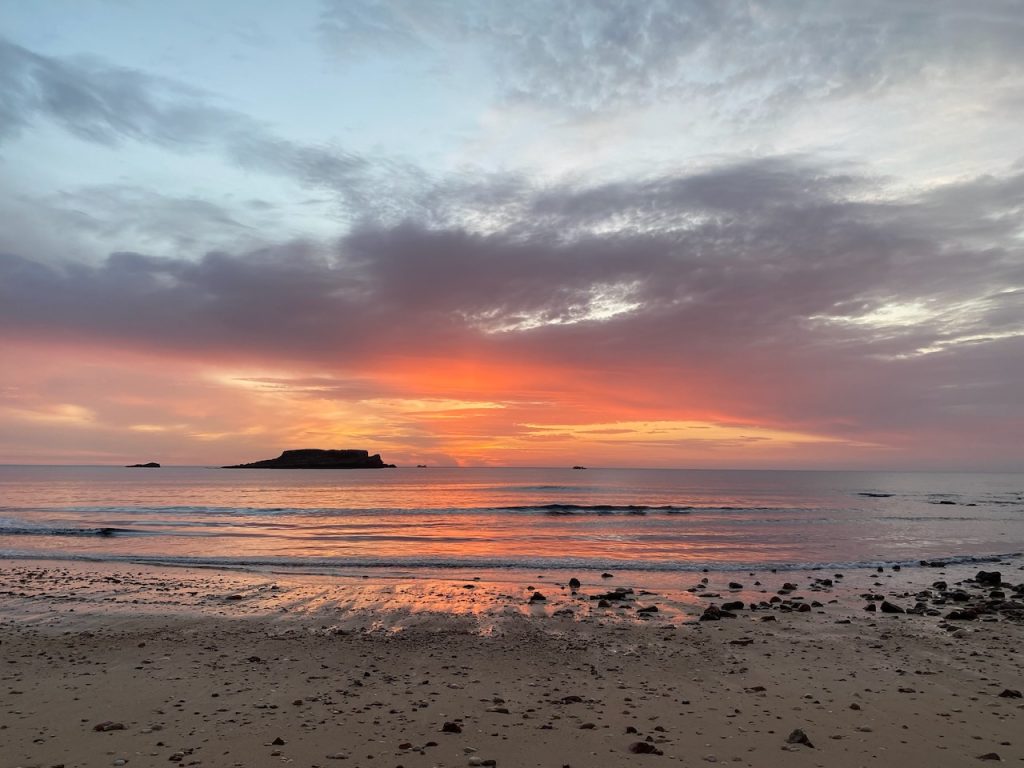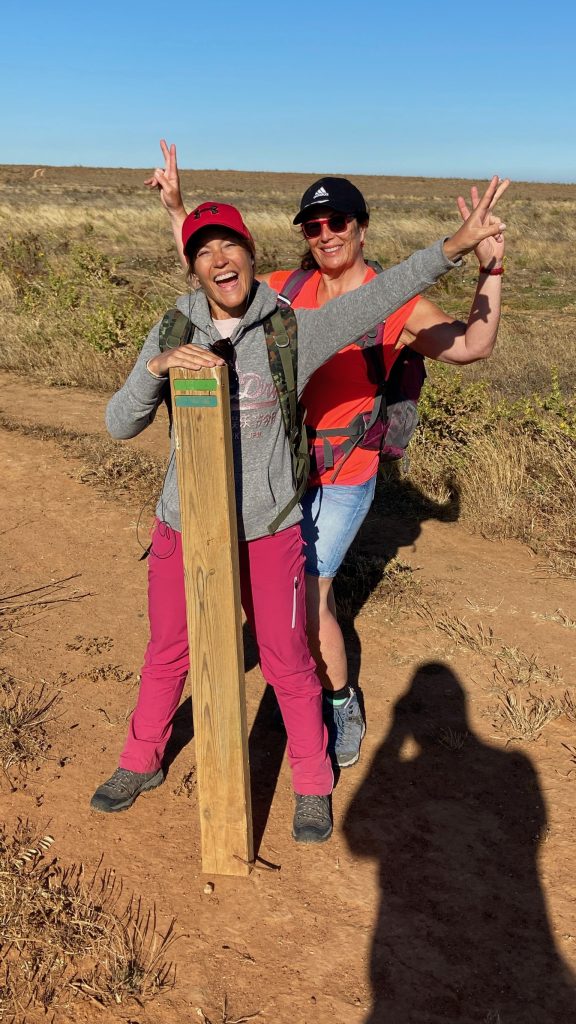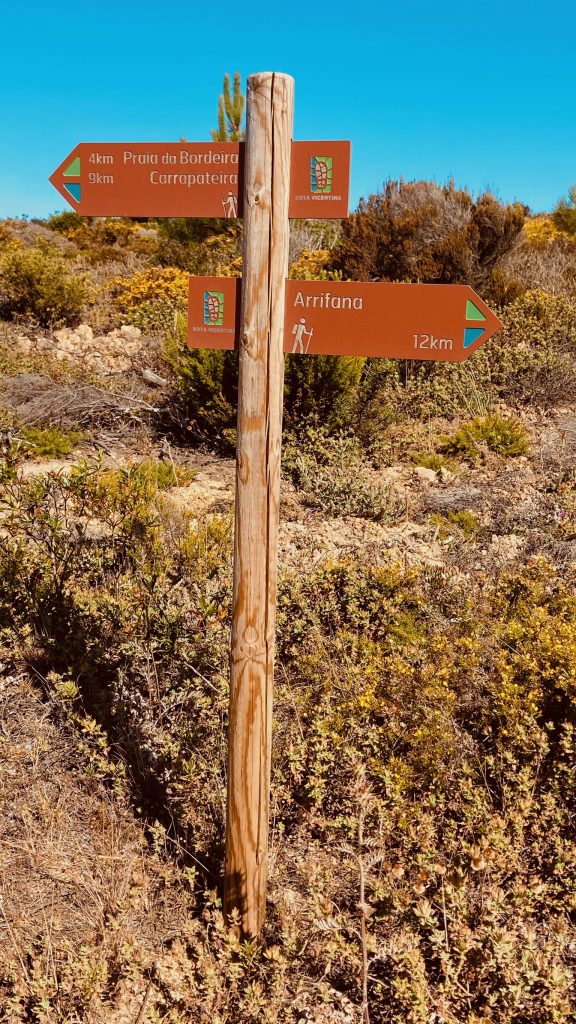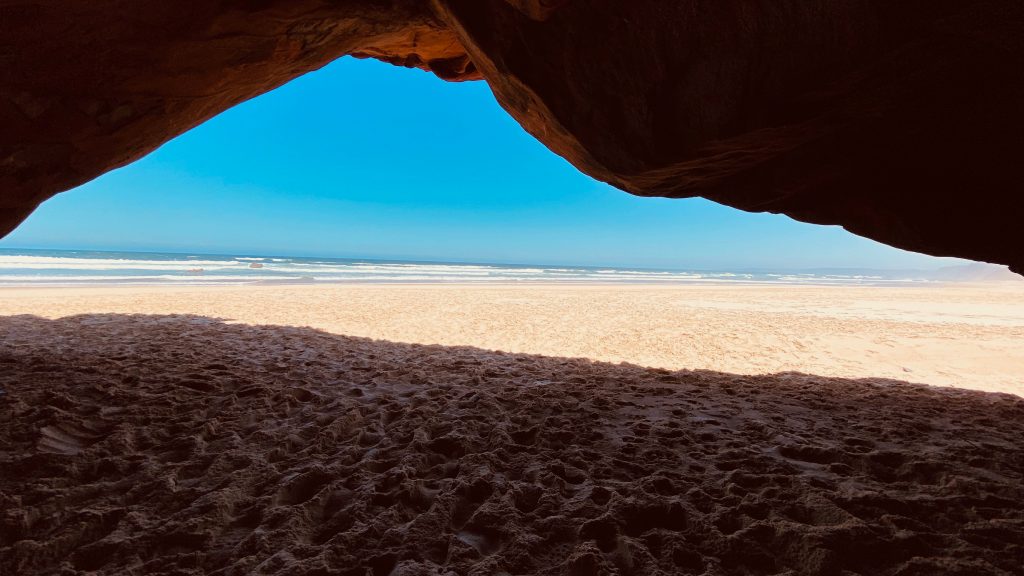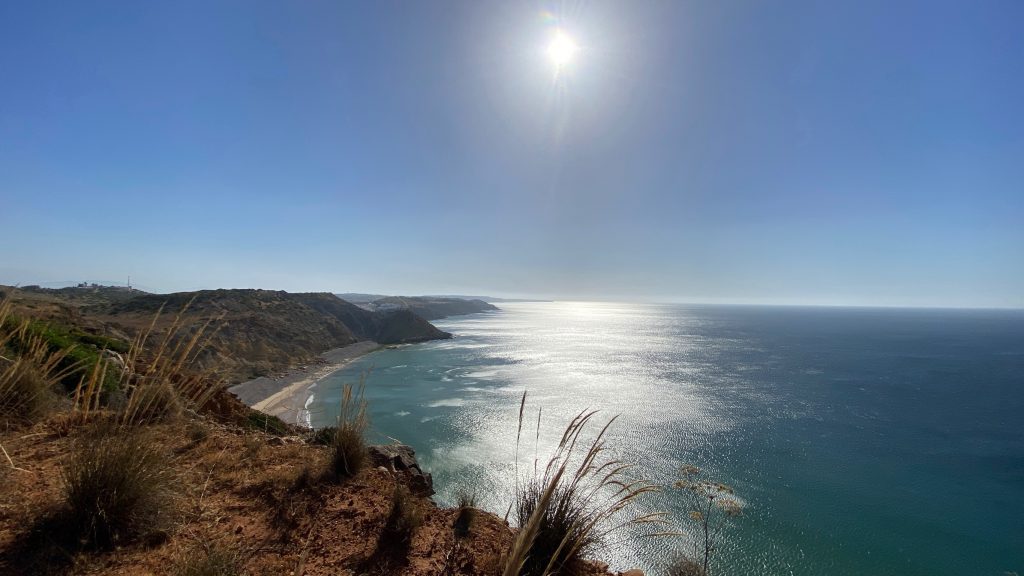Follow the Fisherman Trail (North) –
Atlantic Coast & Algarve
100+ kilometres
Hike stages 1-7 of the Fisherman trail following the Atlantic coastline
Experience
Relax & recharge in the Vicentine Coast Natural Park (Portugal)
6 days
Genuine nature settings, endless ocean views, wild beaches

My Best Time Out
Welcome to your 6 days in motion.
A hike in the breathtaking nature of the Vicentine Coast Natural Park.
The inspiring power of the nature, stillness and time for yourself and the exchange with fellow participants create a unique experience for you to relax, recharge and refocus.
Group of max. 6 selected participants.
Main Highlights:
Porto Covo Old town
Nossa Senhora de Queimada Fortress
Magic Malhão Beach
Mira River delta
Farol Cabo Sardão
Zambujera do Mar Harbour
Odeceixe Mill
Monte Clerico beach and tidal zone
Arrival Day,
Arriving in S. Torpes
After our meeting at Faro Airport we drive to S. Torpes, the starting point of our 6-day journey. After a first glimpse at the Wild Atlantic at the beautiful Praia de São Torpes, we enjoy a joint get-together dinner.
Day 1: S. Torpes –
Porto Covo, 10 km
We will enjoy our breakfast take an easy start today, after the intense traveling the day before. We will hike in a moderate pace along the coastline towards the sun. Certainly we will make a stop at one of the ten beaches on our way.
Day 2: Porto Covo – Vila Nova de Milfontes, 20 km
Today we will explore one of most breathtaking stages of the Fisherman trail, with a lot of variations in the landscape. If we are lucky we will see nesting storks in the cliffs.
Day 3: Vila Nova de Milfontes –
Almograve, 15 km
Today’s stage is very gentle, allowing us to keep our energies. Leaving the river mouth of the Mira river behind us, we follow the coastline, which today is offering us some more bushes and small forests of Eucalyptus and pine trees.
Day 4: Almograve –
Zambujeira do Mar, 22 km
This part of the Fisherman Trail is the most remote and we will enjoy the full immersion into the wild coast and nature. If we look carefully along this coastal stretch it is easy to see past climate change written in the rocks.
Day 5: Zambujeira do Mar –
Odeceixe, 19 km
We will be passing the wildest beaches of the trail on the way to Azenha do Mar, where we will find a natural fishing harbour. To top it all we will enjoy one of the most outstanding views in the entire territory: Odeceixe beach seen from the majestic Ponta em Branco.
Day 6: Odeceixe –
Arrifana, 22 km
We continue from Odeceixe beach, this time on the southern shore, in the lands of the Algarve. We set off to walk further kilometers of fishermen trails, crossing irrigated fields and the coastal heathland, on the way to Arrifana….
For those interested in it –
Some more detail on history, geology and biology along the hike
100+ km following the Fisherman Trail from S. Torpes to Arrifana
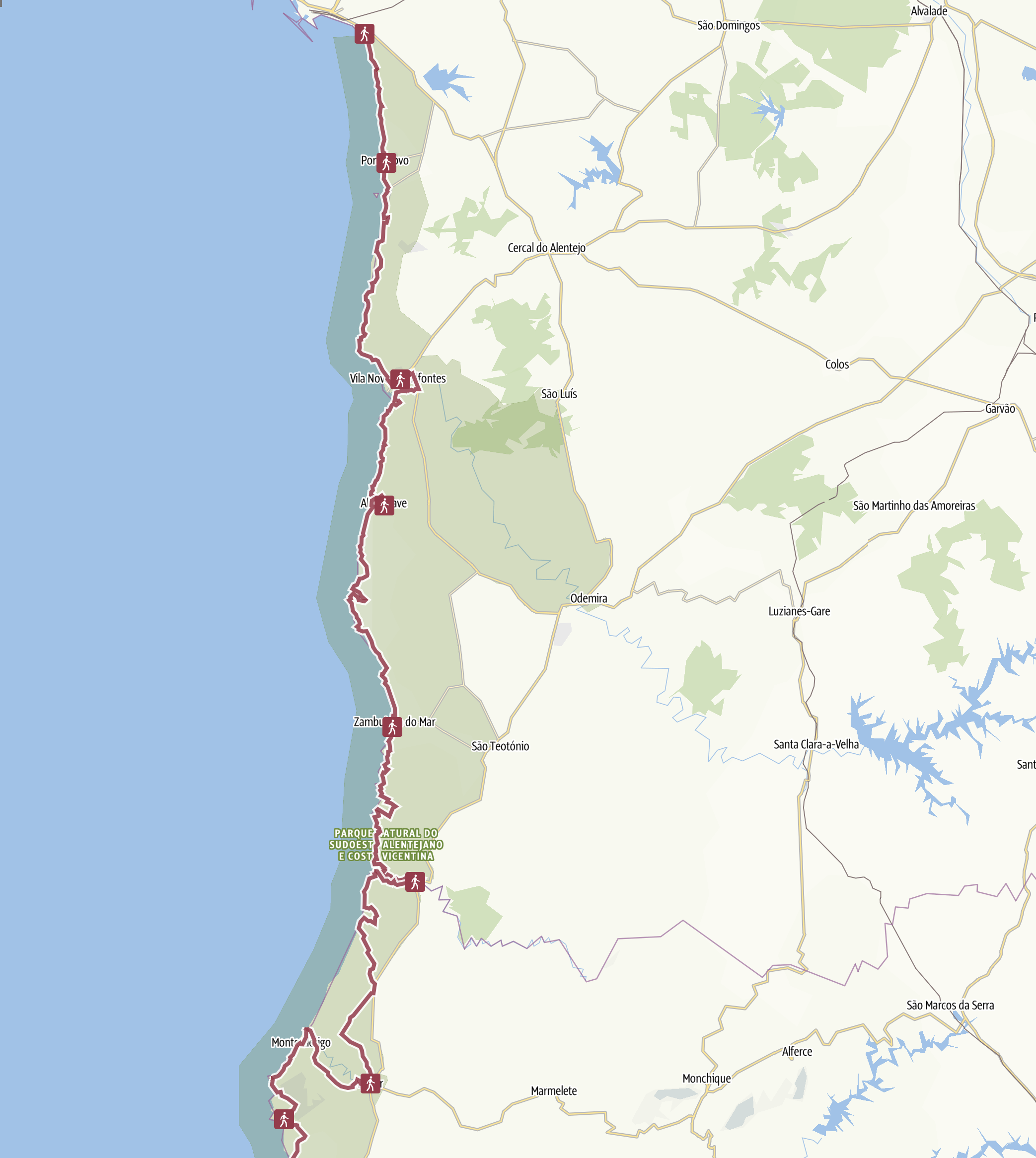
S. Torpes » Porto Covo » Vila Nova de Milfontes
The diversity of beaches you will find just on this section is absolutely fantastic! Beaches like Aivados with pebbles shaped by the constant rough and tumble of the waves. Beaches like Faquir or Farol where lace-like sandstone dunes seem to slide down into the ocean. Sandy beaches like Malhão gently and constantly changing. Beaches such as Milfontes (which means thousand fountains), with either rivers, small streams or tiny fresh water springs fed from the hilly interior through a network of underground channels. These beaches are interspersed by ancient, dark erosion-resistant rocks that make up the cliffs and tiny islands (locally called “palheirões”) that one comes across from time to time.
The sand dunes’ biodiversity and plant life is remarkable and reaches its peak between March and June, with a vast array of amazing colours, aromas and shapes. These plants are true masters of adaptation in this hostile environment and have to put up with poor quality soil, a dry season that can last over six months and a constant buffeting by the strong, salty winds, and you will see that the most obvious adaptation is their shape. Pines, rosemary and rockrose are bent nearly horizontal and thus better adapted to these harsh conditions. Some of these plant species are endemic to this coast and cannot be found anywhere else in the world.
Ready to go?
Reviews
You are protected from any loss of money by our Terms & Conditions. Read more here: Terms & Conditions
What’s included in the price?
Our aim is to create an individual experience for your safe, breathtaking and unforgettable Time Out!
Not included: Flights to/from Faro, extra nights, excursion tickets, lunches, dinners, drinks, individual airport transfer, special voluntary activities: massages, dolphin watching, boat trips
f.a.q.
Our experience shows that six is the ideal group size to create the right balance of diversity and intimacy. It’s small enough to allow for real connection, yet large enough to bring different perspectives and stories into the
space.
For you, this means being part of a carefully chosen group where every voice is heard. For us, it allows the presence and attention needed to support each of you individually, to sense the group’s dynamics, and to ensure that everyone has a unique and meaningful experience.
We walk exclusively on paved hiking trails or along long beaches. The subsoil changes between earth, gravel and sand. A good level of fitness is required to be able to enjoy the daily stages (10 – max. 22 km). Good surefootedness is required for some of the ascents and descents.
No, we recommend not packing more than 10kg in your backpack. Just indulge in minimalism and only pack what is absolutely necessary (see our packing list). A liberating experience of traveling with less luggage. If this is not for you and you don’t want to do without anything, just bring a separate suitcase. We transport this from accommodation to accommodation and you pack what you need for the day in your backpack every day.
We have put together a packing list for you. As said, you are welcome to bring more and we will transport that for you.
We stay in 3* Hotels and B&Bs. You have a comfortable bed and your own bathroom every day. Most of the accommodations are embedded in the small towns along the Fishermans trail and – if you like – also invite you to explore them in the evening.
Strengthening your physical energy is an important part of the retreat. That’s why we pay a lot of attention to nutritious food. The breakfast, which we eat outside in nature, consists of fresh foods rich in vitamins, minerals and proteins, which we procure locally in organic markets and from local producers. In the restaurants and accommodations where we have lunch and dinner, there is a rich offer of local fish and seafood, meat, vegetables and salads. The cuisine is mostly local Portuguese. Appealing vegetarian/vegan options are of course available everywhere. Do you have special needs, just talk to us 🙂
The Algarve climate is mild, little rain, very sunny and has a Mediterranean character. As early as May, temperatures rise to 20°C, from June they quickly climb towards 25°C. However, the Atlantic remains comparatively cool even in midsummer. Only from July do the water temperatures slowly reach a bathing temperature of 20°C.
Extreme heat does not exist in the Algarve. At least not on the coast. Even in midsummer peak values over 30°C are rather the exception. The sea breeze, which reliably blows from the Atlantic to the mainland, also cools you down. In the sheltered hinterland, on the other hand, record temperatures of up to 40°C are not uncommon in July and August.
Most rain falls in southern Portugal between November and March. Despite frequent rainfall, it remains pleasantly mild even during the winter months. During the day, temperatures still reach an average of 15°C to 17°C.
Time outs 2025
Southwest Alentejo and Vicentine Coast Natural park (Portugal)
Southwest Alentejo and Vicentine Coast Natural park (Portugal)
Southwest Alentejo and Vicentine Coast Natural park (Portugal)
We are happy to get to know you in person and to jointly find out,
if a Time Out on the Fisherman Trail is the right thing for you.



